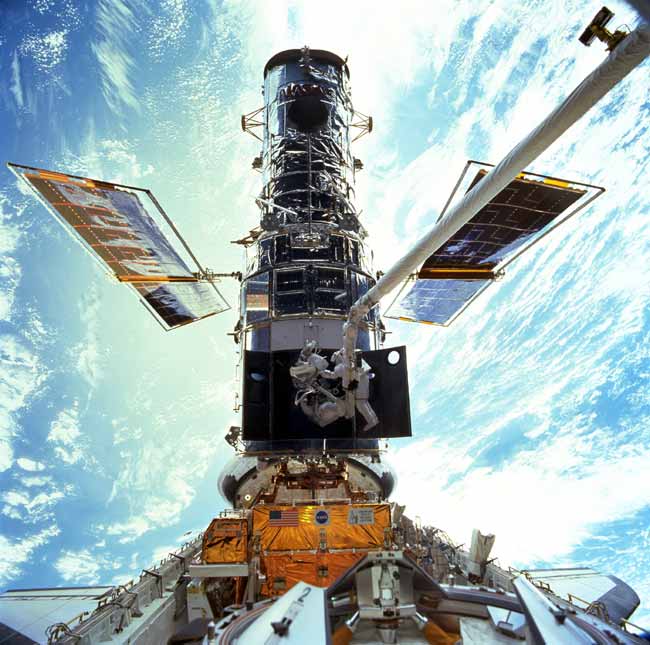Hubble's Final Fix-It Flight Almost Never Was

CAPECANAVERAL, Fla. - The stage is set for NASA?s last trek to the Hubble SpaceTelescope, with seven astronauts and two space shuttles waiting in the wings tofly a risky mission that almost never was.
The missionis STS-125, NASA?s fifth and finalHubble servicing flight, and is poised to launch toward the iconic spacetelescope on May 11 at 2:01 p.m. EDT (1801 GMT) aboard the space shuttleAtlantis. Veteran shuttle commander Scott Altman is leading the charge for the11-day mission, which includes five tricky spacewalks to extend Hubble?s visionand life through at least 2014.
But justreaching this point, with Atlantis days from launch, has been a Herculean featfor NASA given that the agency canceled the mission outright in 2004. Sendinga shuttle to Hubble, beyond reach of the International Space Station,carried too great a risk in the wake of the tragic loss of the shuttle Columbiaand its crew, the agency said then.
?It wasabout the most devastating day that I?ve ever had in my entire life,? Hubble?sprogram scientist David Leckrone said recently while reflecting on that time.?And I think that was true for the entire Hubble team.?
Theannouncement sparked outcry from scientists and the public, not to mentiondisappointment in Altman and his crew.
?As acertified ?Hubble hugger,? that hit me like a two-by-four,? said the mission?slead spacewalker John Grunsfeld, who is making his third trip to Hubble andfifth spaceflight. ?I just couldn?t believe that we would prematurely make thatdecision.?
NASA nowhas a second space shuttle - the Endeavour orbiter - standingby as a rescue ship if Atlantis? crew runs into serious trouble in space,but it was a long and winding road to get to that point.
Get the Space.com Newsletter
Breaking space news, the latest updates on rocket launches, skywatching events and more!
Hubble?shistorical fixes
NASA launchedthe Hubble Space Telescope in 1990 to the cheers of astronomers the world overeager to use its camera eye to peer deep into the universe. It was built byNASA and the European Space Agency specifically so astronauts could performmaintenance and upgrades.
But afterits first two months of tests, the initial images from Hubble were a blurrydisappointment. A slight flaw in the telescope?s main mirror ? barely the widthof a human hair ? fouled the observatory?s vision and some critics later?declared Hubble a national disgrace,? said Ed Weiler, NASA's associateadministrator for science missions, in a recent briefing.
In 1993,NASA sent another shuttle up to Hubble, where astronauts added correctivelenses - essentially glasses - to sharpen its vision. The result was crystalclear: 16 years of stunningcosmic photos followed.
?Somecalled it the miracle-in-space mission,? Weiler said. ?And of course the restis history.?
Since thatfirst orbital fix, astronauts returned to Hubble three more times; in 1997,1999 and 2002. But the 2003 loss of Columbia shook the servicing schedule toits core.
?Servicingwas originally designed to occur approximately every three years, but it?s beenover seven years now,? said Hubble project manager Preston Burch, of NASA'sGoddard Space Flight Center in Greenbelt, Md. ?We have a considerableaccumulation of maintenance items that need to be taken care of.?
At first,NASA stuck by its 2004 decision to leave Hubble to its un-serviced fate. By2005 the space agency, in response to pressure from the public and scientificcommunity, drew a plan to send a robot ? instead of astronauts ? to perform theservice call.
Hubbleoverhaul resurrected
But it wasin September 2006, after the robotic option was deemed untenable, that NASAbacktracked and officially announced its plan to send astronauts to save Hubbleone last time.
Thereasoning was clear. To address the risk posed by Atlantis? inability to ferryits crew to the International Space Station if the shuttle is damaged andcannot return home, NASA would ready Endeavour as a rescue ship. Endeavour asmall crew of four are primed to launch within a week of a declared emergencyto retrieve the Atlantis astronauts.
?It?s avery low probability of an event, but I?m glad that there?s a relatively robustplan to deal with it if it did happen,? commander Altman said in a NASA interview.
Atlantiscannot reach the station from Hubble because the space telescope flies higher(about 350 miles up versus the station?s 220-mile orbit) and in a differentinclination, or tilt with respect to the Earth?s equator.
?I think ofHubble as a rollercoaster,? Weiler said, adding that one thing has become clearin the space telescope?s storied past. ?Everybody loves Hubble now.?
- Video - Hubble?s Repair Missions Revealed
- New Show: Hubble's Universe: The Final Shuttle Service Call
- Image Gallery ? The Hubble Repair Missions: Part 1, Part 2
Join our Space Forums to keep talking space on the latest missions, night sky and more! And if you have a news tip, correction or comment, let us know at: community@space.com.

Tariq is the Editor-in-Chief of Space.com and joined the team in 2001, first as an intern and staff writer, and later as an editor. He covers human spaceflight, exploration and space science, as well as skywatching and entertainment. He became Space.com's Managing Editor in 2009 and Editor-in-Chief in 2019. Before joining Space.com, Tariq was a staff reporter for The Los Angeles Times covering education and city beats in La Habra, Fullerton and Huntington Beach. In October 2022, Tariq received the Harry Kolcum Award for excellence in space reporting from the National Space Club Florida Committee. He is also an Eagle Scout (yes, he has the Space Exploration merit badge) and went to Space Camp four times as a kid and a fifth time as an adult. He has journalism degrees from the University of Southern California and New York University. You can find Tariq at Space.com and as the co-host to the This Week In Space podcast with space historian Rod Pyle on the TWiT network. To see his latest project, you can follow Tariq on Twitter @tariqjmalik.









